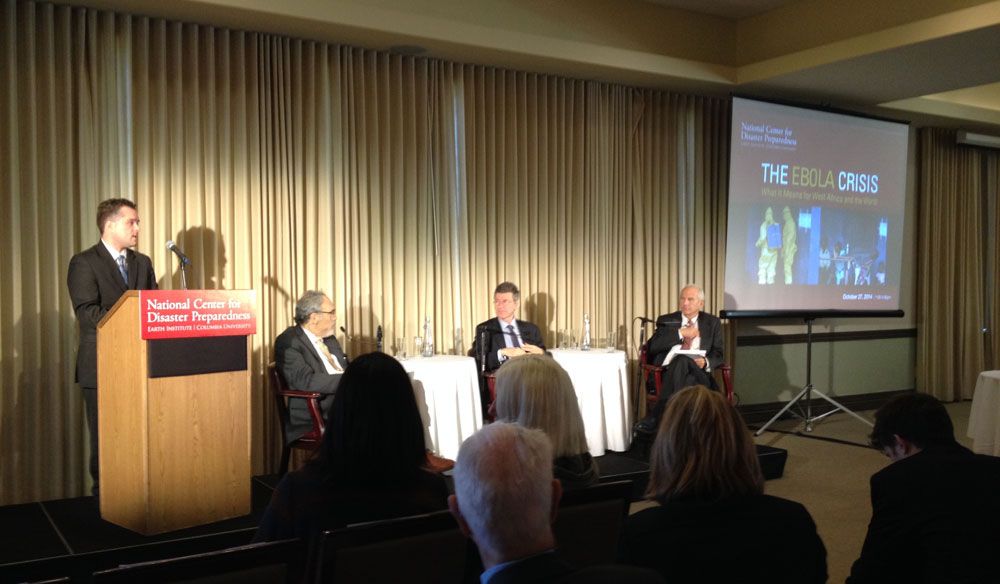Stopping Ebola: How Small Changes Make a Big Difference

NEW YORK — Small changes in the way Ebola interventions are carried out in West Africa could make a big difference in curbing the growth of the epidemic, experts said this week.
"Modest changes of performance," could be the factor that determines whether there is an exponential rise in cases, or the epidemic becomes self-limiting, said Jeffrey Sachs, director of The Earth Institute at Columbia University, who spoke at a conference on Ebola here this week.
At the conference, Sachs showed graphs depicting what would happen in a given Ebola outbreak if the people who were sick with Ebola left their homes to get medical care on the third day that they had symptoms, compared with if they stayed home until the sixth day (and hence infected more members of their households).
With care on the third day, the outbreak would be contained; with care on the sixth day, the outbreak would continue to grow exponentially, according to the model Sachs showed.
"Slight changes to the rate at which an infected individual is picked up [and sent to the hospital leads to] quite dramatic changes in the dynamics of the epidemic," Sachs said. [2014 Ebola Outbreak: Full Coverage of the Viral Epidemic]
Dr. Ranu Dhillon, a senior health advisor at the Earth Institute who is currently in Guinea, agreed. Speaking at the conference via a video call, Dhillon said it's important not to just have more hospital beds, but also to get people with symptoms to hospitals faster. "We can control [the] outbreak with fewer beds than we're talking about now," if people with Ebola are transported to the hospital more quickly, Dhillon said.
Other small changes, such as better identification of Ebola cases and safer burials, may also make a big difference, Sachs said. To stop the growth of the outbreak, health officials need to reduce the number of new people who a given person with Ebola infects (the so-called "reproduction number") to less than one, on average, Sachs said. (The reproduction number during the current Ebola outbreak is between 1.5 and 2.5, according to a recent study in the journal PLOS Currents: Outbreaks.)
Sign up for the Live Science daily newsletter now
Get the world’s most fascinating discoveries delivered straight to your inbox.
As of Oct. 24, more than 10,000 people had become sick with Ebola, and 4,900 had died, in Guinea, Liberia and Sierra Leone, according to the Centers for Disease Control and Prevention.
Health officials have repeatedly said that they know how to stop Ebola outbreaks — by identifying people who have contact with Ebola patients, following them for 21 days, testing them if they develop symptoms, and ensuring safe burials, and repeating the cycle until the chain of transmission is stopped, said Anne Liu, associate director of Health Systems Development at the Earth Institute.
However, "this can become very complicated with many moving pieces, Liu said. "Any gap in the chain allows for Ebola transmission to continue."
An important step to help prevent those gaps would be to put in place stronger management systems to coordinate all of the people involved in stopping the chain of transmission, Liu said. "This is an urgent epidemic and we cannot afford to lose time."
There are a number of other challenges in addressing the Ebola outbreak. Dhillon said that in Guinea, there are just two laboratories capable of performing the tests for Ebola, which makes testing for the virus difficult.
In addition, people with Ebola are hesitant to come forward to health officials, because they see the treatment as a death sentence, Dhillon said. Care needs to improve, Dhillon said, because people will only come forward if they know there is hope for getting better.
Trust is also an issue, and building trust among people in the community would help health officials better understand where cases are occurring, Dhillon said.
Dhillon called for a greater sense of urgency in responding to the West African outbreak. "There are difficult steps that need to be taken, but we don’t have a choice," Dhillon said. "If what's happening here were happening across the state of New York, what would we do and how would we act?"
Follow Rachael Rettner @RachaelRettner. FollowLive Science @livescience, Facebook& Google+. Original article on Live Science

Rachael is a Live Science contributor, and was a former channel editor and senior writer for Live Science between 2010 and 2022. She has a master's degree in journalism from New York University's Science, Health and Environmental Reporting Program. She also holds a B.S. in molecular biology and an M.S. in biology from the University of California, San Diego. Her work has appeared in Scienceline, The Washington Post and Scientific American.










